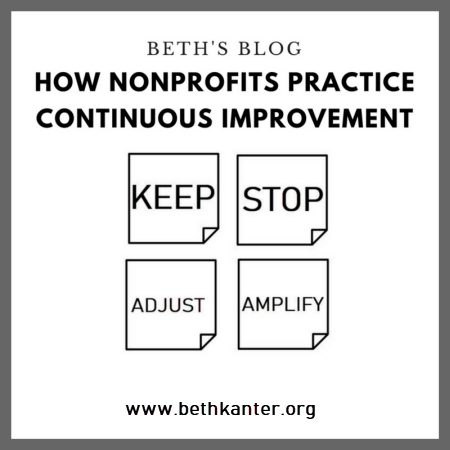
I’m just back from spending a week in Bangkok, Thailand at the IFC-ASIA: Ecosystems for Good. I co-lead a workshop on digital transformation, co-facilitated a master class on digital fundraising campaigns, co-hosted a learning breakfast for scholarship participants, co-designed a Big Room session on Technology for Good, and in between attended some amazing sessions. I also served on the program advisory committee.
It was a lot of learning in a short time-period and I’ll be unpacking and sharing it here on this blog over the coming weeks. Rather than start at the beginning, I’m starting at the end by sharing some tips for a formal reflection process that can lead to improving results of a project or event.
A structured reflection process generates insights about what worked and what could be improved. More importantly, it can avoid replicating mistakes or activities that don’t work and are a waste of resources.
One of the simplest ways to practice continuous improvement is to incorporate a process evaluation. It is important to write down observations as the event or program unfolds because if you wait until the event is over, there is a chance you won’t remember it in vivid detail. I know this sounds like extra work, especially after an intense event like a conference when everyone is exhausted, but it will pay your organization back by improving results.
It isn’t just about writing it down, it is also reviewing what your captured with your team in an “After Action Review.” And, of course, your evaluation will also include looking at the data from surveys and interviews with participants after the event. In short, the process boils down to these steps:
- Capture the lesson learned (big or small) from your own observations or asking for informal feedback from participants during the event
- Use a google document (or create a Slack channel or What’s App group) so your team can capture during the event
- Ask team members to reflect on their lessons learned
- Review it together in a meeting and summarize
- Survey participants and incorporate their feedback

The Process Steps in Detail
Our advisory committee includes Courtney Lawrence from DSIL, a company that focuses on innovation and human centered design practices, who lead us through our reflection process. What I liked best about the process is that was streamlined and simple, yet powerful. It took us approximately 60 minutes.
1) During the event or program, advisory committee members were asked to write down their observations as well as get informal feedback participants. We used a private group on What’s App to do this during the event so it was simple to capture. We also met as a group every morning and shared what we were learning over breakfast.
2) Immediately after the event, we did a formal debrief. We had several flip chart pages on the wall that were divided into quarters with the following labels: Keep, Delete, Adjust, Amplify. We looked at following areas: content, logistics, social, communication, and pre-planning. We had about 10-15 minutes individually to write down our thoughts on different sticky notes and put them in the appropriate page and section.
3) Next, we divided into small groups that worked on each area to synthesize the notes into key themes and followed by a rapid report out to the full group.
4) The next step is compare these top level themes against the participant evaluation.(We also worked on developing personas and questions for post event interviews – I’ll save that reflecting on that process for another blog post.)
This was a simple post event debrief and internal evaluation to look at ways to improve it in the next year. Does your nonprofit use a formal debrief process after programs, events, or activities? What is your process? How has it helped your organization get better results.
Additional Reading
How To Routinize Reflection – https://bethkanter.org/reflection-routine/
Facilitator Guide: http://www.emergingleader.co/toolkit/routinize-reflection/
Keep Calm and Write It Down – https://bethkanter.org/keep-reflect/
After Action Review Guide – https://www.cebma.org/wp-content/uploads/Guide-to-the-after_action_review.pdf

Leave a Reply